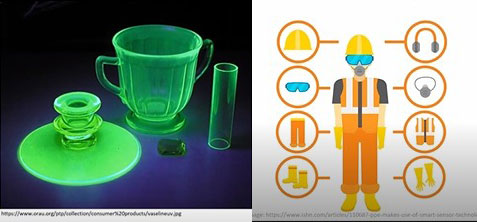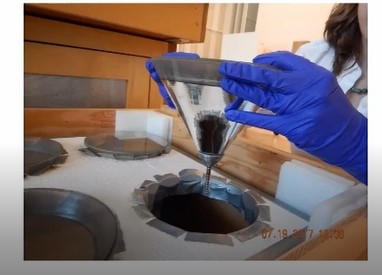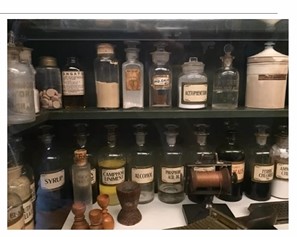Speakers:
- Haddon Dine, Assistant Objects Conservator at the Art Institute of Chicago
- Jeff Sotek, Senior Associate at Wood Environmental & Infrastructure Solutions
Jeff Sotek, Senior Associate at Wood Environmental & Infrastructure Solutions, started off the event by talking about the field of industrial hygiene and how industrial hygienists can work with conservators. Industrial hygiene is the science field of enhancing and protecting the health and safety of people at work and in their communities. There is a broad range of physical, ergonomic, biological, and chemical stressors that health and safety hazards cover. It’s the role of the industrial hygienist to recognize, anticipate, evaluate, and control those hazards. Thus, when industrial hygienists network with local conservation groups, they can provide technical support; for example, they can provide recommendations for grant support, targeted local and portable ventilation, health and safety employee training (such as respirator fitting), and exposure assessments to determine which chemicals (if any) affect employees and contractors. Haddon Dine, Assistant Objects Conservator at the Art Institute of Chicago, then gave a brief overview of the field of art conservation. Conservators may be exposed to hazards from their materials, their tools, and the cultural heritage objects they are treating. Conservators may work in museums, private studios, and regional centers, where they may or may not have sufficient safety equipment or access to safety professionals. This is especially important for conservators in private practice studios, as it is up to them to learn and implement proper safety practices.

The American Institute for Conservation (AIC) Health & Safety Network is a group that works to increase conservators’ knowledge of health and safety information regarding hazards, control measures, and general health issues. They publish articles and monthly columns, conduct presentations, and provide other resources. For example, AIC established the Health & Safety Wiki. This resource provides information to increase knowledge of general health issues and safety hazards in the conservation profession. The AIC Health & Safety Network works closely with the American Industrial Hygiene Association (AIHA) Museum and Cultural Heritage Industry (MCHI) Working Group, a group of professionals that focus on health and safety in the museum and cultural heritage industry. The AIHA MCHI initiatives include:
- Developing Occupational Environmental Health Solutions (OEHS) core curriculum for museum studies programs
- Providing museum occupational learning opportunities for public health undergraduates and graduate students
- Promoting Occupational Safety and Health Administration (OSHA) small business and on-site consultation services to employers of non-government-funded small museums and other cultural institutions

Three case studies were then shared by Sotek, wherein he identified examples of hazardous materials from specific collections and the role of the industrial hygienist. The first case study centered around an exhibit that consisted of seven funnels filled with 3–5 oz. of mercury. The artwork was in storage , and the museum planned to re-display it for the first time since the 1980s. The problem: mercury in the funnels had developed a black “goo/sludge”. The response: an industrial hygienist was called in to assess the black “goo/sludge”, to determine whether the artwork was safe for display, and the proper protocols for hazardous waste disposal if that was necessary. The black goo was estimated to be mercuric (II) sulfide. The hazard evaluation included an air quality assessment and mapping the route of exposure. The industrial hygienist recommended local exhaust, advice regarding personal protective equipment (PPE), mercury handling training, and establishing protocols for spill control.
The second case study featured an apothecary museum with an extensive collection of different pharmaceutical and dental items, dating back to the turn of the 19th century. The museum requested assistance in inventory, cataloging, and disposal of unwanted material. They also wanted to determine whether the materials posed a threat to visitors, museum staff, and contracted conservators. One of the challenges faced was that some of the small containers had no labels, which was a common practice back in the day. The products in those containers could be innocuous or they could contain unknown hazards (such as being poisonous, flammable, radioactive, or corrosive). Recommendations were given for local ventilation, respiratory protection and fit testing, medical clearance, training in collection handling, and grant preparation.

The final case study featured taxidermy specimens and other organic collections, such as Native American baskets. The taxidermy specimens included an alligator, a red-tailed hawk, Canadian geese, mergansers, songbirds, butterflies, horse skulls, and orangutans. Historical attempts to preserve these collections included treating the specimens and other organic objects with pesticides, arsenic, mercury chloride, formaldehyde, and other chemicals. The museum needed assistance to determine what chemicals were in the taxidermy collection. After the initial review, some of the collections were identified to contain traces of arsenic and mercury. Gaps in the museum’s health and safety procedures were also identified. The industrial hygienist provided recommendations for targeted local and portable ventilation, OSHA compliance, employee training, as well as job and PPE hazard analysis.
The networking benefits between industrial hygienists and conservators extends beyond these case studies of hazard assessment and risk management support. It provides access to technical resources, such as the respirator fit testing events and co-sponsored events like the annual Safety & Cultural Heritage Summit and forthcoming OSHA consultation program for small museums, historic houses, and other small organizations.